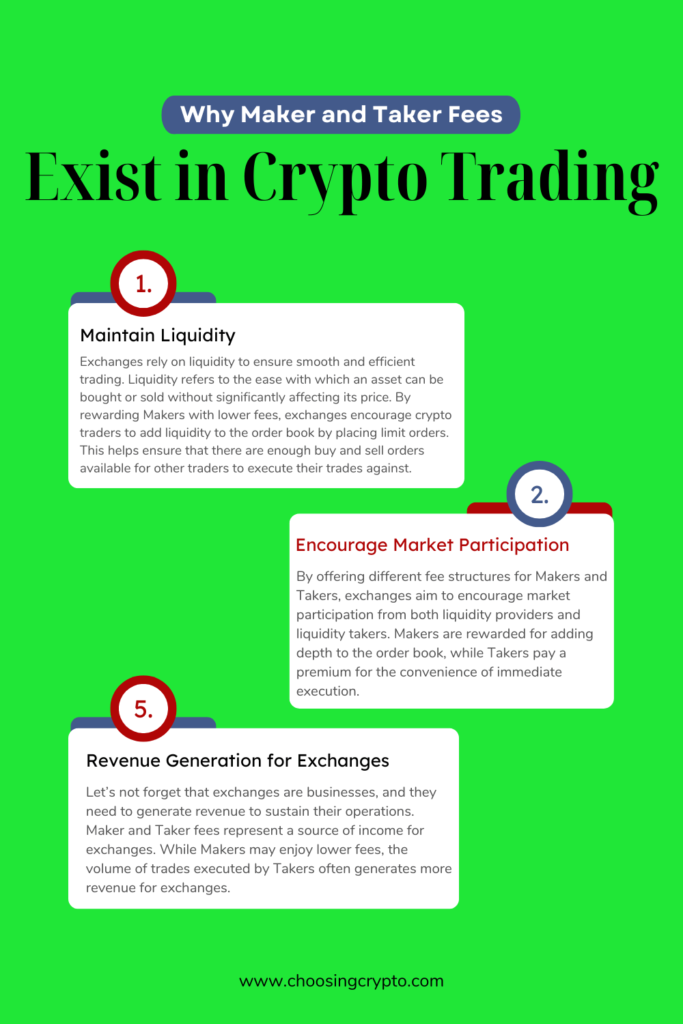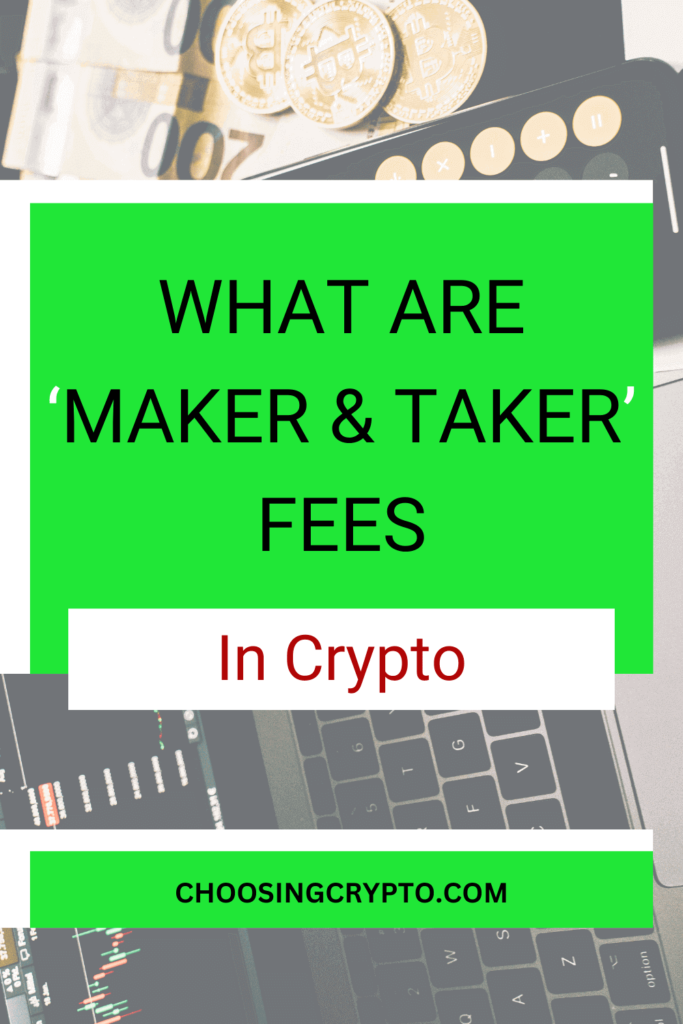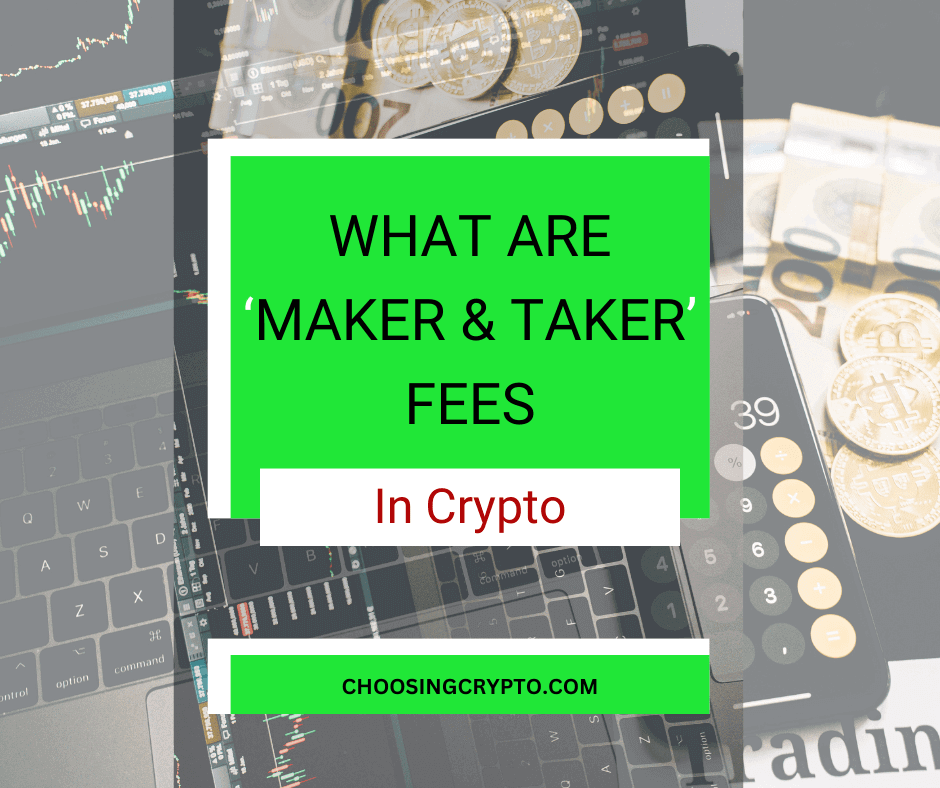Have you ever wondered what those Maker and Taker fees in crypto are all about?
Don’t worry; you’re not the only one confused.
I’m here to make things crystal clear about Maker and Taker fees, explaining them in a way that even your grandma could grasp.
So, grab a snack and get comfy, because we’re going into this intriguing topic together.
In this post, I’ll break down what Maker and Taker fees are, how they’re different, and why they exist.
Plus, I’ll share some handy tips to help you keep those fees to a minimum.
So, if you’re keen to up your crypto game and become a pro-crypto trader, stick around!
IMPORTANT: I've selected some really great blog posts that I think you'll absolutely love. They're waiting for you right at the bottom of this post. Don't forget to give them a read!What is a Maker Fee in Crypto?
A maker fee is a fee charged to crypto traders who provide liquidity to the market by placing a limit order that isn’t immediately filled.
In simpler terms, if you place a buy or sell order on an exchange and wait for someone else to match it, you’re a maker! As a reward for adding liquidity to the exchange, you often get charged a lower fee compared to takers.
Think of it like this: by placing a limit order, you’re essentially adding to the order book, creating opportunities for other traders to execute their orders against yours. This helps keep the market moving smoothly and efficiently, which is why exchanges often reward makers with lower fees.
So, the next time you place a limit order on a crypto exchange, remember that you’re not just trading – you’re also playing a crucial role in keeping the whole trading system going smoothly.
What is a Taker Fee in Crypto?
A taker fee is what you pay when you place an order that matches immediately with an existing order on the exchange.
In simpler terms, if you’re buying or selling at the current market price and your order gets filled right away, you’re a taker!
Taker fees are typically higher than maker fees because, essentially, you’re taking liquidity away from the market.
Instead of adding to the order book like makers do, you’re consuming liquidity by executing against existing orders.
So, the next time you place a market order on a crypto exchange, remember that while you’re getting what you want straight away, you’re also paying a little extra for the privilege.
Difference Between Maker and Taker Fees in Crypto
Now that we understand what maker and taker fees are, let’s explore the key differences between them.
- Timing of Orders:
- Maker Fee: Maker fees apply when traders place limit orders that aren’t immediately matched with existing orders on the exchange. These orders add liquidity to the market and help shape the order book.
- Taker Fee: Taker fees come into play when traders place market orders or limit orders that are immediately matched with existing orders on the exchange. These orders consume liquidity from the order book.
- Order Execution:
- Maker Fee: Maker orders wait on the order book until they are matched with a taker order. They essentially “make” liquidity available for others to trade against.
- Taker Fee: Taker orders are executed immediately by matching with existing maker orders on the order book. They “take” liquidity from the market.
- Fee Structure:
- Maker Fee: Typically, maker fees are lower than taker fees. Exchanges often incentivize makers by charging them lower fees as a reward for adding liquidity to the market.
- Taker Fee: Taker fees are generally higher than maker fees because they involve immediate order execution and consume liquidity from the market.
Read Also: Difference Between SegWit and Legacy Bitcoin Addresses
Why Maker and Taker Fees Exist in Crypto Trading
Let’s talk about why Maker and Taker fees are a thing in crypto trading:
- Maintain Liquidity: Exchanges rely on liquidity to ensure smooth and efficient trading. Liquidity refers to the ease with which an asset can be bought or sold without significantly affecting its price. By rewarding Makers with lower fees, exchanges encourage crypto traders to add liquidity to the order book by placing limit orders. This helps ensure that there are enough buy and sell orders available for other traders to execute their trades against.
- Encourage Market Participation: By offering different fee structures for Makers and Takers, exchanges aim to encourage market participation from both liquidity providers and liquidity takers. Makers are rewarded for adding depth to the order book, while Takers pay a premium for the convenience of immediate execution.
- Revenue Generation for Exchanges: Let’s not forget that exchanges are businesses, and they need to generate revenue to sustain their operations. Maker and Taker fees represent a source of income for exchanges. While Makers may enjoy lower fees, the volume of trades executed by Takers often generates more revenue for exchanges.

Real-World Examples of Maker and Taker Fees in Crypto
To better understand how Maker and Taker fees work in practice, let’s walk through a couple of real-world scenarios:
Scenario 1: Making Liquidity as a Maker:
Imagine you’re into crypto trading and want to buy 1 Bitcoin (BTC) on Binance. You decide to place a limit order to buy BTC at £50,000, which is a bit lower than the current market price of £51,000. So, your order sits there, waiting for someone to sell at your price.
In this scenario:
- You are acting as a Maker because you’ve placed a limit order that adds liquidity to the order book.
- When your order eventually gets filled, you’ll pay the Maker fee, which is usually cheaper than the Taker fee.
- Your Maker fee rewards you for adding liquidity, even if your order doesn’t get filled straight away.
Scenario 2: Taking Liquidity as a Taker:
Now, let’s say you’re in a rush to buy 1 Bitcoin and decide to place a market order on Gate.io. The current market price is £51,000 per BTC. Your market order instantly matches with someone selling on the order book, and you get your 1 BTC straight away at the current market price.
In this scenario:
- You’re the Taker because your market order eats up liquidity straight from the order book.
- As a Taker, you’ll pay the Taker fee, which is usually higher than the Maker fee.
- Your Taker fee compensates the Makers for letting you trade straight away and helps keep the market liquid.
Tips to Minimize Maker and Taker Fees in Crypto Trading
When you trade cryptocurrencies, you usually end up paying Maker and Taker fees. But there are smart ways to keep these fees low and manage your trading costs effectively.
Let me share some handy tips with you:
- Use Limit Orders: Instead of just jumping in with market orders, try using limit orders. This way, you become a ‘Maker’ and pay less in fees.
- Choose Exchanges Wisely: Don’t just settle for any exchange. Do some digging into the fee structures of different ones. Look for crypto exchanges that offer fair fees and transparent fee schedules.
- Time Your Trades: Trade when there’s higher liquidity and lower volatility. Higher liquidity can result in tighter bid-ask spreads, reducing the impact of Taker fees.
Read Also: How to Choose a Crypto Exchange
Additional Resources:
Excited to learn more about Bitcoin and cryptocurrencies? We’ve got some awesome resources below to help you out.
- The Importance of Liquidity in Crypto Trading
- How to Avoid Losses in Crypto Trading
- What is Leverage Trading in Crypto? A Beginner’s Guide
- Crypto Trading Strategies for Different Market Conditions
- What are Trading Pairs in Cryptocurrency? A Beginner’s Guide
And guess what? We’re also on Instagram and Twitter(X). Join us there for even more fun and useful content!

DISCLAIMER:
The information provided here is intended for informational purposes only and should not be solely relied upon for making investment decisions. It does not constitute financial, tax, legal, or accounting advice. Additionally, I strongly recommend that you only invest in cryptocurrency an amount you are comfortable with potentially losing temporarily.
Read Also: 20 Things You Should Never Do as a Crypto Investor/Trader
